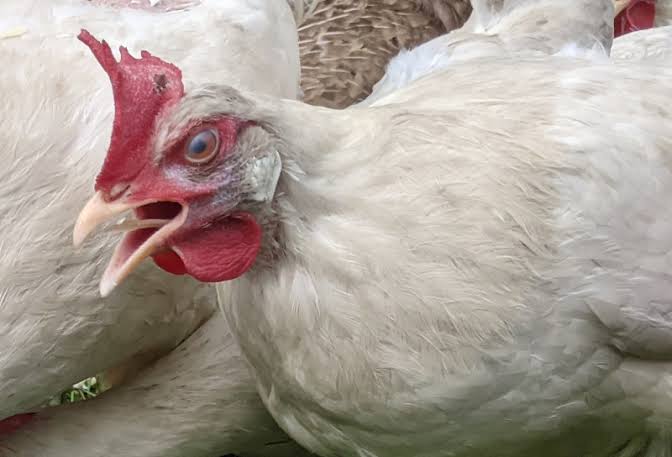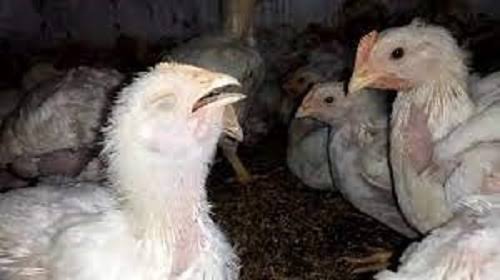Infectious Bronchitis, scientifically known as Avian Infectious Bronchitis Virus (IBV), is a contagious respiratory disease affecting poultry. This viral infection primarily targets chickens, causing considerable economic losses in the poultry industry worldwide.
The virus primarily spreads through respiratory droplets, with infected birds shedding the virus through their nasal discharge and respiratory secretions. Once introduced into a flock, the virus swiftly spreads among birds housed in close proximity.
Affected chickens typically exhibit clinical signs such as sneezing, coughing, and nasal discharge. Additionally, a drop in egg production and poor eggshell quality are common manifestations. The disease can lead to reduced weight gain in broilers, impacting overall flock performance.
Avian Infectious Bronchitis Virus belongs to the coronavirus family, which includes viruses causing diseases in various animals and humans. The genetic diversity of IBV strains poses a challenge in developing effective vaccines, as the virus can mutate over time. Consequently, multiple strains of the virus coexist, complicating prevention and control efforts.
Control measures include vaccination, biosecurity practices, and proper management strategies. Vaccination helps in reducing the severity of clinical signs and minimizing economic losses. However, it’s essential to choose the right vaccine based on the prevalent IBV strain in a specific region.
Maintaining strict biosecurity measures, such as limiting visitor access, disinfecting equipment, and controlling the movement of people between farms, is crucial to preventing the introduction and spread of the virus. Proper management practices, including maintaining optimal environmental conditions and ensuring good nutrition, also play a vital role in minimizing the impact of Infectious Bronchitis on poultry farms.
Early detection of the virus is essential for implementing prompt control measures. Diagnostic tools, such as polymerase chain reaction (PCR) tests, help in identifying the presence of IBV in a flock. Timely diagnosis enables farmers to take immediate action to contain the spread of the virus and mitigate its impact.
Infectious Bronchitis poses a significant threat to poultry health and production. Understanding the virus’s transmission dynamics, implementing effective control measures, and staying informed about the latest developments in vaccination strategies are crucial for poultry farmers to safeguard their flocks and maintain the sustainability of the poultry industry.
Read Also: Predators, Parasites and Diseases of Snail and Controls
Animals Affected by Infectious Bronchitis (Avian Infectious Bronchitis Virus)

Infectious Bronchitis primarily affects chickens, particularly those raised for meat (broilers) and egg-laying hens. The virus is highly contagious among poultry and can lead to significant economic losses in the poultry industry. Other than chickens, infectious bronchitis may also infect other domesticated fowl such as turkeys, ducks, and quail, albeit with varying severity.
The impact of the virus on different bird species can vary, and while chickens are the most commonly affected, it’s essential for poultry farmers to be aware of the potential risks to other avian species in their vicinity. The transmission dynamics and clinical manifestations in non-chicken species may differ, making it important to consider a broader approach to infectious bronchitis prevention and control in mixed-species environments.
Efforts to control the spread of infectious bronchitis should encompass biosecurity measures not only for chickens but also for other susceptible birds within the same geographical area. This includes strict controls on the movement of birds, people, and equipment between different types of poultry farms to prevent cross-species transmission.
However, while chickens are the primary target of Infectious Bronchitis, it’s crucial for poultry farmers to be vigilant about potential transmission to other avian species, emphasizing comprehensive biosecurity measures to mitigate the risks across different types of poultry.
Damages Caused by Infectious Bronchitis

Infectious Bronchitis causes a range of damages in poultry, impacting both the health of the birds and the economic viability of poultry farming operations. The damages include:
1. Respiratory Distress: The virus primarily targets the respiratory system, leading to symptoms such as coughing, sneezing, and nasal discharge. Affected birds may experience respiratory distress, impacting their overall well-being.
2. Reduced Egg Production: Egg-laying hens infected with Infectious Bronchitis often exhibit a drop in egg production. The virus can affect the reproductive organs, leading to decreased egg output and poor eggshell quality. This reduction in egg production is a significant economic concern for poultry farmers.
3. Poor Weight Gain in Broilers: Broiler chickens, raised for meat production, may experience reduced weight gain due to the impact of Infectious Bronchitis on their respiratory and digestive systems. This results in decreased overall productivity and increased production costs.
4. Increased Mortality: Severe forms of Infectious Bronchitis can lead to increased mortality rates, especially in young chicks. The virus weakens the birds’ immune systems, making them more susceptible to secondary bacterial infections that can be fatal.
5. Economic Losses: The cumulative effect of respiratory distress, reduced egg production, poor weight gain, and increased mortality results in substantial economic losses for poultry farmers. The costs associated with veterinary care, decreased productivity, and potential culling of infected birds contribute to the financial impact.
6. Challenges in Vaccine Development: The genetic diversity of Infectious Bronchitis Virus strains poses challenges in vaccine development. Continuous mutations in the virus make it difficult to create vaccines that provide broad-spectrum protection. This adds complexity to disease prevention and control strategies.
7. Biosecurity Measures: Implementing stringent biosecurity measures to prevent the spread of Infectious Bronchitis adds operational costs to poultry farming. These measures include restricting access, disinfecting equipment, and controlling the movement of people, all of which contribute to increased management expenses.
Infectious Bronchitis inflicts significant damages on poultry, affecting both the health of the birds and the economic viability of poultry farming operations. The development and implementation of effective prevention and control measures, including vaccination and biosecurity practices, are crucial for minimizing the impact of this viral infection.
Read Also: Basic Snail Farming Tools and Equipment
Control and Preventive Measures

Controlling and preventing the spread of Infectious Bronchitis in poultry requires a comprehensive approach, involving various measures to mitigate the impact of the virus. Key strategies include:
1. Vaccination Programs: Implementing a well-designed vaccination program is crucial for controlling Infectious Bronchitis. Vaccines are developed based on prevalent virus strains, and their use helps reduce the severity of clinical signs and limit the spread of the virus within a flock.
2. Biosecurity Practices: Strict biosecurity measures are essential to prevent the introduction and spread of Infectious Bronchitis on poultry farms. This includes limiting access to farms, proper disinfection of equipment, and establishing controlled zones to avoid cross-contamination between different areas.
3. Quarantine Protocols: Introducing new birds to a flock without proper quarantine increases the risk of disease transmission. Implementing quarantine protocols for new arrivals helps detect and isolate potentially infected individuals before they can spread the virus to the existing flock.
4. Environmental Management: Maintaining optimal environmental conditions, including proper ventilation and temperature control, helps reduce stress on the birds. Stress can exacerbate the impact of Infectious Bronchitis, so creating a comfortable and clean environment is crucial.
5. Nutritional Management: Providing a well-balanced and nutritious diet supports the overall health and immune function of poultry. Proper nutrition can contribute to stronger immune responses, reducing the susceptibility of birds to infectious diseases like Infectious Bronchitis.
6. Monitoring and Surveillance: Regular monitoring of poultry flocks for clinical signs, coupled with surveillance testing using diagnostic tools like polymerase chain reaction (PCR) tests, helps in early detection of Infectious Bronchitis. Early identification allows for timely implementation of control measures.
7. Education and Training: Educating farm personnel about the nature of Infectious Bronchitis, its transmission dynamics, and the importance of biosecurity measures is crucial. Training programs can empower farmers and workers to recognize and respond effectively to potential outbreaks.
8. Veterinary Support: Establishing a strong relationship with a poultry veterinarian is essential. Regular veterinary visits can aid in disease prevention, diagnostics, and the development of customized control strategies based on the specific challenges faced by a particular farm.
9. Record Keeping: Maintaining detailed records of flock health, vaccination history, and any observed clinical signs facilitates better disease management. Accurate records enable farmers and veterinarians to track trends and make informed decisions for future flock management.
Additionally, a combination of vaccination, biosecurity practices, proper management, and ongoing monitoring is essential for controlling and preventing the spread of Infectious Bronchitis in poultry. Implementing these measures collectively helps maintain the health and productivity of poultry flocks while minimizing economic losses for farmers.
Frequently Asked Questions (FAQs) About Infectious Bronchitis (Avian Infectious Bronchitis Virus)
1. Q: What is Infectious Bronchitis?
A: Infectious Bronchitis is a highly contagious viral respiratory disease that primarily affects chickens, causing symptoms such as coughing, sneezing, and nasal discharge.
2. Q: Can other birds besides chickens get infected with Infectious Bronchitis?
A: Yes, other domesticated fowl such as turkeys, ducks, and quail can also get infected, but the severity and symptoms may vary.
3. Q: How does Infectious Bronchitis spread among poultry?
A: The virus spreads through respiratory droplets from infected birds, contaminating the environment. Direct contact and shared equipment can also contribute to transmission.
4. Q: What are the clinical signs of Infectious Bronchitis in chickens?
A: Clinical signs include respiratory distress, coughing, sneezing, nasal discharge, reduced egg production, and poor eggshell quality. Broilers may also experience poor weight gain.
5. Q: Can humans contract Infectious Bronchitis from infected poultry?
A: No, Infectious Bronchitis is specific to birds and does not pose a risk to human health.
6. Q: How is Infectious Bronchitis diagnosed?
A: Diagnosis involves laboratory tests such as polymerase chain reaction (PCR) to detect the presence of the virus in respiratory samples.
7. Q: Is there a vaccine for Infectious Bronchitis?
A: Yes, vaccines are available and play a crucial role in controlling the disease. Vaccination programs are tailored based on prevalent virus strains.
8. Q: What biosecurity measures are important to prevent Infectious Bronchitis?
A: Biosecurity measures include limiting farm access, disinfecting equipment, implementing quarantine for new arrivals, and controlling the movement of people between different areas.
9. Q: How can farmers reduce the economic impact of Infectious Bronchitis?
A: Farmers can reduce the economic impact through proper vaccination, biosecurity practices, environmental and nutritional management, and early detection with regular monitoring.
10. Q: What should I do if I suspect Infectious Bronchitis in my flock?
A: Contact a poultry veterinarian immediately for a proper diagnosis and guidance on implementing control measures. Isolate affected birds and follow biosecurity protocols to prevent further spread.

